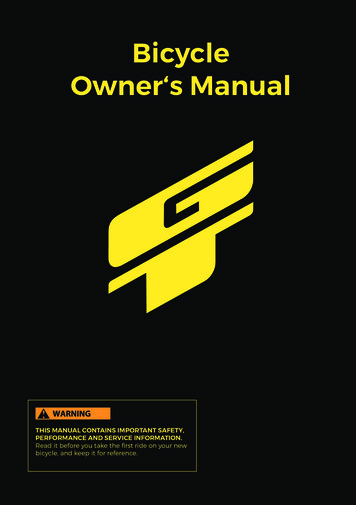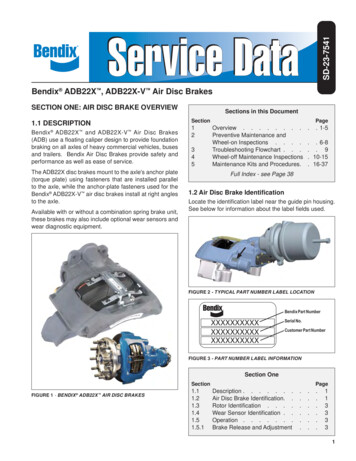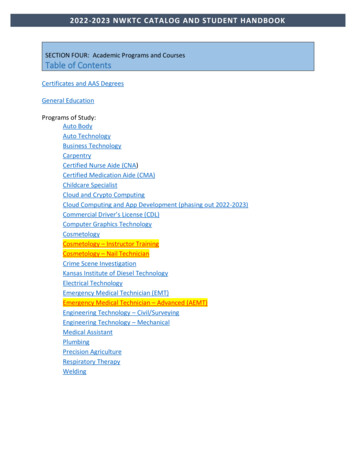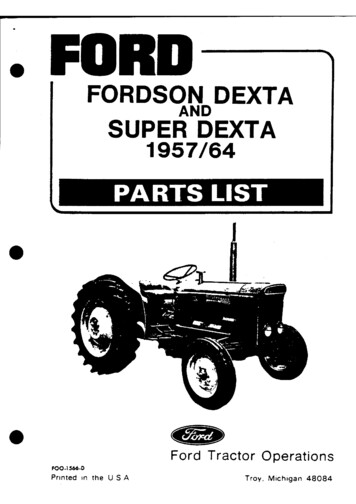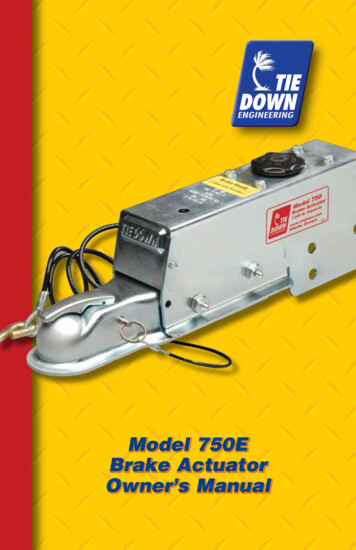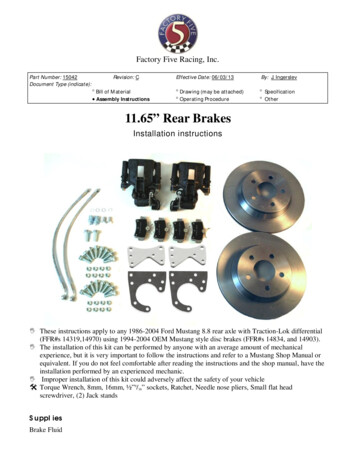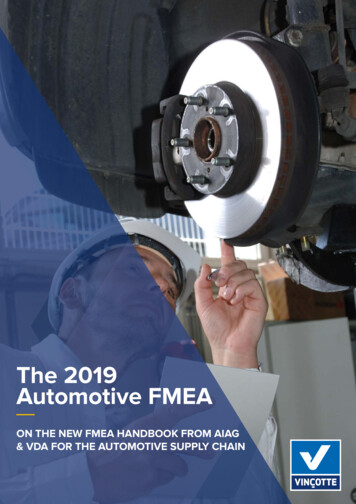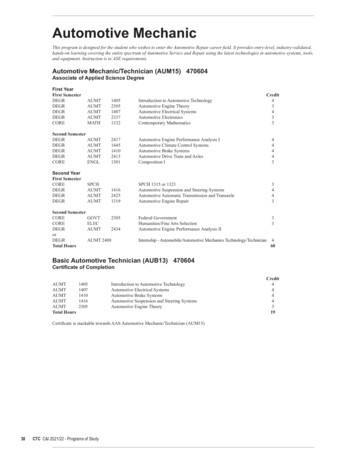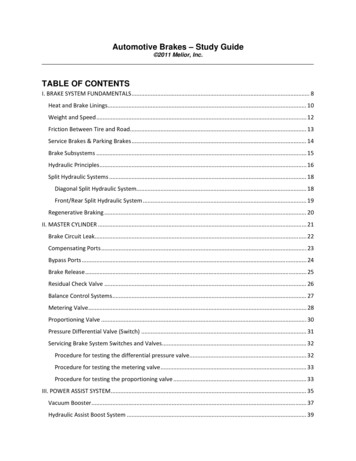
Transcription
Automotive Brakes – Study Guide 2011 Melior, Inc.TABLE OF CONTENTSI. BRAKE SYSTEM FUNDAMENTALS . 8Heat and Brake Linings. 10Weight and Speed . 12Friction Between Tire and Road. 13Service Brakes & Parking Brakes . 14Brake Subsystems . 15Hydraulic Principles . 16Split Hydraulic Systems . 18Diagonal Split Hydraulic System. 18Front/Rear Split Hydraulic System . 19Regenerative Braking . 20II. MASTER CYLINDER . 21Brake Circuit Leak. 22Compensating Ports . 23Bypass Ports . 24Brake Release . 25Residual Check Valve . 26Balance Control Systems . 27Metering Valve . 28Proportioning Valve . 30Pressure Differential Valve (Switch) . 31Servicing Brake System Switches and Valves . 32Procedure for testing the differential pressure valve. 32Procedure for testing the metering valve . 33Procedure for testing the proportioning valve . 33III. POWER ASSIST SYSTEM . 35Vacuum Booster . 37Hydraulic Assist Boost System . 39
Diagnosing Power‐Assisted Brake Systems. 41Diagnosing vacuum‐boost power brake systems . 41Diagnosing hydraulically‐assisted power brakes . 42Repairing Power Boosters . 43IV. DISC BRAKES . 44Disc Brake Caliper . 45Disc Brake Rotors . 49Measuring rotor lateral runout . 49Measuring rotor thickness variation . 50Rotor Refinishing . 51Inspect and Diagnose Disc Brake Systems . 52Visually inspecting the disc brake system . 52Determining the cause of pulsating pedal or brake fade . 53Service Disc Brake Calipers . 56Removing disc brake calipers . 56Inspecting and repairing calipers . 57Installing and adjusting disc brake calipers. 59Service Disc Brake Rotors . 61Determining rotor thickness, parallelism, and runout . 61Machining rotors off the vehicle . 63Machining rotors on the vehicle . 66Preparation for machining rotors . 66V. Reading Micrometers . 69Reading an English Micrometer . 70Reading a Metric Micrometer . 72VI. DRUM BRAKES . 73Duo‐servo Brakes . 74Brake Drum . 75Brake Shoes . 75Wheel Cylinder . 76Brake Anchors . 77Backing Plate . 77
Duo‐servo Brake Operation . 78Self‐Adjusters . 79Leading‐Trailing Brake Operation . 80Brake Drum Inspection . 81Measuring Brake Drums . 81Inspecting and Diagnosing the Drum Brake System . 84Visually inspecting the drum brake system . 84Disassembling, Inspecting, and Servicing the Drum Brake System . 89Procedures for disassembling and inspecting a drum brake assembly . 89Disassembling and Inspecting the Wheel Cylinder . 93Installing and Adjusting Drum Brake Components . 95Machine Brake Drums . 97Brake Service Tips . 100VII. BRAKE FLUID AND BLEEDING BRAKE SYSTEMS. 101The Selection and Handling of Brake Fluid . 102Storing Brake Fluid . 102Handling Brake Fluid . 102Selecting Brake Fluid . 103Procedure for Adding Brake Fluid . 104Brake Bleeding Fundamentals . 105Master Cylinder Bleeding . 105Pressure Bleeding. 106Manual Bleeding . 108Bleeding the Brake System . 110Procedure for manually bleeding the brake system . 110Procedure for pressure bleeding the brake system. 111Procedure for vacuum bleeding the brakes. 113Servicing the Master Cylinder . 114Inspecting the master cylinder . 114Procedure for checking the master cylinder for external leaks . 114Procedure for checking the operation of the master cylinder . 114Removing, Bench Bleeding, and Replacing the Master Cylinder . 115
Removing the master cylinder . 115Bench bleeding. 116Inspecting and Adjusting Brake Pedal Free Height and Travel . 117Procedure for determining the brake pedal free height and travel . 117Procedure for adjusting brake pedal free travel . 118VIII. PARKING BRAKE . 119Parking Brake ‐ Drum (Duo‐servo) . 120Disc Brakes with Integral Parking Brake . 121Screw and Nut Parking Brake . 121Ball‐and‐Ramp Parking Brake. 122Drum‐In‐Hat Parking Brake . 123Mechanical Brake System Components. 124Inspecting and Adjusting Drum Parking Brakes . 125Procedure for inspecting integrated parking brakes . 125Procedure for inspecting auxiliary drum parking brake . 125Procedure for adjusting integrated and auxiliary parking brake systems . 125Inspecting and Adjusting Disc Parking Brakes. 126Testing Parking Brake Performance . 126Testing the Parking Brake Indicator Light . 126Testing the Brake Light Circuit . 127Testing the Brake Warning Light . 127IX. BRAKE LINES AND HOSES . 129Brake Hoses. 131Servicing Hydraulic Brake Plumbing . 132Inspecting and replacing brake lines and hoses . 132X. WHEEL BEARING SERVICE AND ADJUSTMENT . 133Inspecting and Servicing Nonsealed Wheel Bearings . 134Procedure for inspecting nonsealed wheel bearings. 134Procedure for servicing nonsealed wheel bearings . 134Adjusting Nonsealed Wheel Bearings and Tightening Sealed Wheel Bearings . 137Procedure for adjusting nonsealed bearings (typical front‐wheel‐drive wheel bearing arrangement). 137
Procedure for tightening sealed wheel bearings . 138Inspecting and Servicing Sealed Bearings . 139Procedure for inspecting sealed wheel bearings . 139Procedure for removing and replacing sealed wheel bearings . 139Inspecting and Replacing Wheel Studs . 139XI. ANTILOCK BRAKES AND TRACTION CONTROL SYSTEMS . 141Overview of Antilock Brake Systems . 141The function of antilock brake systems . 141Antilock Brake System Components . 143Speed sensors . 143Brake modulator . 144ABS controller . 144Variations in the Antilock Brake System Design . 145Integrated hydraulic assembly design . 146Nonintegrated system design . 146Other system designs . 147Traction Control System Function and Components . 148Stability Control System Function and Components . 149Diagnose and Service Antilock Brake Systems . 150Characteristics Unique to Antilock Braking Systems . 150Precautions for Servicing Antilock Brake Systems . 150Recognizing Normal ABS Functions . 151Diagnosing Antilock Brake Systems . 152Diagnosing Intermittent Electrical Problems . 153Servicing Individual ABS Components . 154Servicing speed sensors . 154Powertrain control module (PCM) . 154Warning lamps and brake system diagnosis . 155Servicing a brake pedal travel switch. 155Hydraulic assembly . 156XII. BRAKE DIAGNOSIS PROCEDURES . 157The Work Order . 157
Brake Diagnosis ‐ Initial Steps . 158Visual Inspection . 159Detailed Visual Inspection. 161Brake Pedal Checks . 162Test Drive . 163Procedure for preparing a vehicle for a road test . 163Procedure for road testing the vehicle . 163Safety Precautions for Dealing With Asbestos . 165The dry method of encapsulation . 165The wet method of encapsulation . 172Safety Precautions for Lifting a Vehicle . 173Troubleshooting Various Brake System Problems . 174Diagnosing brakes that pull, drag, or stop the vehicle poorly . 174Contaminated brake fluid . 176Troubleshooting the brake system . 176
INTRODUCTION TO BRAKE SYSTEMSEverybody knows that when you press your foot on the brake pedal the vehicle is supposed to stop,but how does the pressure from your foot get to the wheels with enough force to stop a heavyvehicle?In the following sections, we are going to study the systems and components required to causebrakes to work effectively.Course ObjectivesUpon completion of this course, technicians should understand and be able to apply their knowledgeof: Brake functions and componentsSplit hydraulic systemsMaster cylinder operationsBalance control systemsPower brake booster systemsDisc brake operationMicrometer readingDrum brake operationBrake fluidsBrake bleeding operationsBrake lines and hosesWheel bearing serviceAntilock brakes and traction control systemsBasic diagnosis
I. BRAKE SYSTEM FUNDAMENTALSAutomotive brakes are designed to slow and stop a vehicle by transforming kinetic energy (motionenergy) into heat energy. As the brake linings contact the drums/rotors they create friction whichproduces the heat energy. The intensity of the heat is proportional to the vehicle speed, the weight ofthe vehicle, and the quickness of the stop. Faster speeds, heavier vehicles, and quicker stops equalmore heat.Principles of FrictionFriction is the resistance to movement that results from two objects moving or rubbing against eachother. There are two types of friction: kinetic and static.Kinetic friction occurs between two objects, one of which is moving. Kinetic friction alwaysproduces heat. The more kinetic friction produced, the more heat produced. Automotive brakingsystems use kinetic friction to convert the energy of a moving vehicle into heat.Static friction occurs between two objects that are stationary. Automotive braking systems usestatic friction to hold a vehicle while it is parked. Static friction produces no heat.Various factors affect the amount of friction produced between two objects. The rougher the surfacesof two objects, the more friction they produce. Extremely rough surfaces create the most friction, butrough surfaces also wear down quickly. Therefore, automotive brakes use relatively smooth surfacesto avoid rapid wear. In order to compensate for their smooth surfaces, automotive brakes are appliedwith a great amount of pressure over a relatively large contact area.The greater the pressure bringing the objects together, the more friction they produce. Therefore, thegreater the pressure applied to the brakes, with all other factors equal, the greater their stoppingpower.The greater the amount of shared contact area between two objects, the greater the amount offriction the objects produce. Automotive braking systems use the largest contact area possible. Thegreater the contact area of a brake shoe or pad, the less heat the shoe or pad generates. Less heatallows for more friction, which makes the brakes more efficient.The greater the contact area of a brake shoe or pad, the less heat the shoe or pad generatesper square inch.
Note: On drum brake systems, a brake shoe is applied to a brake drum to create friction. On discbrake systems, a brake pad is applied to a disc to create friction.The hotter the friction surface of two objects, the less friction produced. (Rub your hands togetherand feel the heat!)All heat that the brake system creates must dissipate as rapidly as it is created. The brake systemcan store little or no heat. Brake friction surfaces are made of a material that can conduct heateasily. Braking system components that produce friction (brake shoes or brake pads) are positionedso that air cools them. In some braking systems, forced air cools the components.The amount of friction that two objects produce when rubbing against each other is calledthe coefficient of friction.
Heat and Brake LiningsAn important brake friction surface is the brake lining that is mounted on either a brake shoe orbrake pad. The brake lining produces friction by directly contacting another friction surface, either abrake drum or disc. The brake lining and the material that it touches must have the following specialcharacteristics.The brake drum or disc must conduct heat easily, hold its shape under extremely high heat,withstand rapid temperature changes, resist warping and distortion, and wear well in general.Therefore, brake drums and discs are typically constructed of iron or steel combined with aluminum.The brake lining must be somewhat softer than the brake drum or disc. At present, most brakelinings are made of organic materials, metallic particles, and other minerals held together by abonding agent.Note: For years, asbestos was commonly used in brake linings. Because asbestos is a cancercausing substance, federal law prohibits its use in brake systems.When the brake lining is applied to a drum or disc, it is important that the proper coefficient of frictionis produced in order to ensure that the brakes are effective. If the friction coefficient is too great, the brakes may be "grabby" or overly sensitive. Overlysensitive brakes may cause the vehicle to skid too easily.If the friction coefficient is too low, brake application requires excessive pressure. Applyingthe brakes with excessive pressure creates excessive heat that could result in brake failure.Note: Heat always reduces the coefficient of friction between two objects. Hence, high temperaturesmay cause brakes to fail. The loss of brake effectiveness due to heat created during prolonged hardbraking is called brake fade. If the brakes create more heat than they can dissipate, the friction coefficient reduces, whichcauses the brakes to fade.Excessive heat also causes bonding agents in the lining to melt and flow to the surface,which produces a glaze on the shoe lining. This glaze reduces the brake's friction coefficientand causes more brake fading. Brake application then requires more pressure, thus creatingmore heat and more glazing.
The amount of friction that two objects produce when rubbing against each other is calledthe coefficient of friction.
Weight and Spe
produces heat. The more kinetic friction produced, the more heat produced. Automotive braking systems use kinetic friction to convert the energy of a moving vehicle into heat. Static friction occurs between two objects that are stationary. Automotive braking systems use static friction to hold a vehicle while it is parked.

